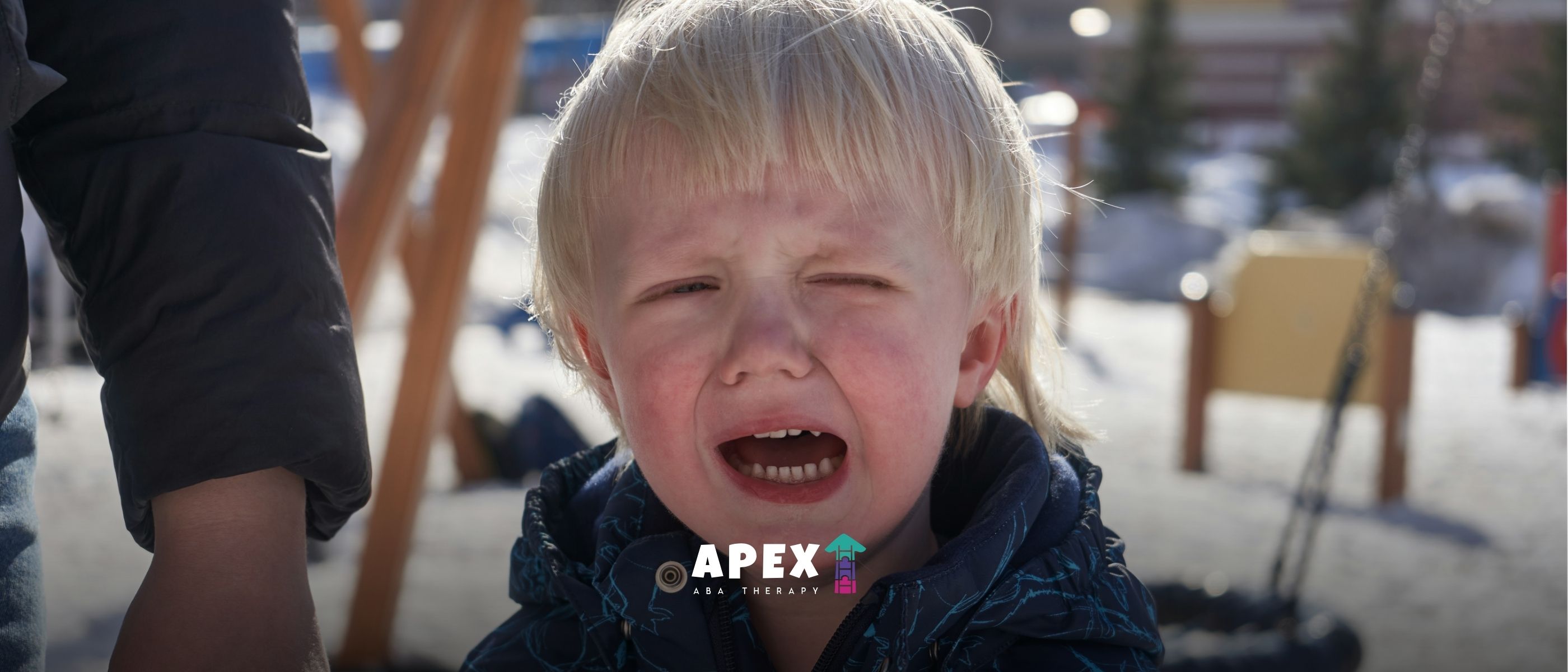Elopement And Autism: What To Do When Your Child Elopes?
Elopement, also known as wandering, is a common behavior among individuals with autism spectrum disorder (ASD). It refers to the act of leaving a safe space without permission or supervision.
.jpg)
Elopement And Autism: What To Do When Your Child Elopes?
Understanding Elopement
Elopement is a serious concern for individuals with Autism Spectrum Disorder (ASD). It can occur for a variety of reasons, making it important to understand the underlying causes in order to prevent it from happening.
One reason for elopement is sensory seeking. Individuals with ASD may wander away from a safe space in search of a specific sensory experience, such as the feeling of sand or mud under their feet, or the sound of birds chirping in the trees.

This can be a difficult behavior to manage, as it is important for individuals with ASD to have access to sensory experiences in a safe and controlled environment.
Another reason for elopement is a lack of safety awareness. Individuals with ASD may not understand the potential danger of wandering away from a safe space.
For example, they may not realize the risk of getting lost or wandering into a busy street. It is important to teach safety skills to individuals with ASD in order to prevent elopement and keep them safe.
Communication difficulties can also contribute to elopement. Individuals with ASD may not be able to express their needs or wants effectively, leading them to wander away in search of something they need or want.
It is important to provide individuals with ASD with effective communication tools and strategies to help them express themselves and reduce the likelihood of elopement.
In conclusion, elopement is a complex behavior that can occur for a variety of reasons. Understanding the underlying causes and providing appropriate support and interventions can help prevent elopement and keep individuals with ASD safe.
The Link Between Elopement and Autism
Individuals with autism spectrum disorder (ASD) are at a higher risk of elopement than their typically developing peers. Studies have shown that up to half of children with ASD engage in wandering behavior, making it a significant concern for families and caregivers.
The reasons behind this link between elopement and ASD are not fully understood, but some researchers believe that it may be related to sensory processing issues.
Individuals with ASD may have difficulty processing sensory information and seeking out certain sensory experiences through elopement may be a way to regulate or satisfy their sensory needs.
Another potential factor is the social communication difficulties experienced by individuals with ASD. They may wander away from safe spaces in search of social interaction or communication opportunities, as they struggle to connect with others in traditional ways.
Regardless of the underlying reason, it is important for families and caregivers to be aware of the increased risk of elopement among individuals with ASD. By understanding the link between autism and elopement, we can better develop strategies to prevent wandering behavior and keep individuals with ASD safe.
Early Intervention to Prevent Elopement
Early intervention is crucial in preventing elopement among individuals with Autism Spectrum Disorder (ASD). It is important for caregivers and professionals to be aware of the signs and risk factors associated with elopement, so that appropriate interventions can be made as early as possible.
One effective strategy for preventing elopement is to create a safe and secure environment. This may involve installing locks on doors and windows, using child-proof safety gates, or implementing a tracking system.
Creating a consistent routine and providing clear communication can also help individuals with ASD feel secure and reduce the likelihood of elopement.
Another important aspect of early intervention is teaching safety skills. This includes teaching individuals with ASD about potential dangers in their environment, how to recognize when they are lost or in an unsafe situation, and how to ask for help.
Providing individuals with effective communication tools can also help them express their needs and wants without resorting to elopement.
In addition to these strategies, it is important for caregivers and professionals to work together to develop individualized plans based on the unique needs of each person with ASD. Early intervention can make a significant difference in preventing elopement and ensuring the safety of individuals with ASD.
Preventing Elopement
Preventing elopement is crucial to ensure the safety and well-being of individuals with ASD. Here are some strategies that can help:
1. Develop a safety plan
A safety plan is a tool that can be used to identify potential elopement triggers and develop strategies to prevent it from happening. The plan should include information about the individual's routines, interests, and sensory needs, as well as strategies for communicating with them effectively.
2. Create a safe environment
Creating a safe environment is essential to prevent elopement. This can include installing locks on doors and windows, using alarms or tracking devices, and creating a fenced-in area for outdoor play.
3. Teach safety skills
Teaching safety skills is an important part of preventing elopement. This can include teaching individuals with ASD about road safety, stranger danger, and how to ask for help if they are lost.
4. Use visual supports
Visual supports can be helpful in preventing elopement. This can include using picture schedules, social stories, and visual cues to help individuals with ASD understand the expectations and routines of their daily lives.
The Benefits of Wearable Technology in Preventing Elopement
Wearable technology, such as GPS trackers and smartwatches, can be a valuable tool in preventing elopement among individuals with Autism Spectrum Disorder (ASD).
One major benefit of wearable technology is the ability to track a person's location in real time. This can provide peace of mind for caregivers and allow them to quickly locate an individual who has wandered away from a safe space.
In addition, some devices offer geofencing capabilities, which allow caregivers to set boundaries around safe areas and receive alerts if the individual leaves that area.
Another benefit of wearable technology is the ability to customize alerts and notifications.
Caregivers can receive alerts when an individual leaves a designated area or if they remove the device. In addition, some devices offer features such as "safe zones," which are pre-determined locations where the individual is allowed to go without triggering an alert.
Wearable technology can also be beneficial for individuals with ASD. Some devices offer features such as reminders and schedules, which can help individuals stay on track and reduce anxiety.
In addition, some devices offer communication tools, such as text messaging or video calling features, which can help individuals connect with their caregivers or loved ones in a safe and secure way.
Overall, wearable technology can be a powerful tool in preventing elopement among individuals with ASD. By providing real-time tracking, customizable alerts, and additional benefits for individuals with ASD themselves, wearable technology can help ensure the safety and well-being of those who are at risk of elopement.
Strategies for Tracking and Finding a Missing Individual with ASD
Despite the best efforts of caregivers, elopement can still occur. In the event that an individual with Autism Spectrum Disorder (ASD) goes missing, it is important to have strategies in place to quickly locate them and ensure their safety.
One effective strategy is to create a search team. This team should include family members, friends, neighbors, and local law enforcement. It is important to provide each member of the search team with a clear description of the individual's appearance, as well as any relevant information about their interests or routines.
Another important strategy is to utilize technology. In addition to wearable devices, there are a variety of apps and services available that can help locate a missing individual with ASD. These may include GPS tracking apps or online databases that allow caregivers to register their loved one's information in case they go missing.
It is also important to act quickly when an individual with ASD goes missing. Time is of the essence in these situations, so it is important to contact local law enforcement immediately and provide them with all relevant information about the missing person.
Finally, it is important to have a plan in place for what happens after the individual is found. This may include medical evaluations or therapy sessions to address any trauma or anxiety they may have experienced during their time away from home.
By implementing these strategies and having a plan in place for locating and ensuring the safety of individuals with ASD who go missing due to elopement, we can help reduce the risks associated with this behavior and keep our loved ones safe.
Creating a Support Network for Families and Caregivers of Individuals with ASD who Wander
Caring for an individual with Autism Spectrum Disorder (ASD) who wanders can be a challenging and isolating experience. It is important for families and caregivers to have a support network in place to help them navigate the complexities of this behavior and provide emotional support.
One way to create a support network is to connect with other families and caregivers who have experienced similar challenges. This can be done through online forums, social media groups, or local support groups. These networks can provide valuable resources, advice, and emotional support for families and caregivers.
In addition to connecting with other families, it is important for families and caregivers to work closely with professionals who can provide guidance and support.
This may include therapists, behavior analysts, or educators who specialize in working with individuals with ASD who wander. These professionals can help develop individualized plans and strategies to prevent elopement and keep individuals with ASD safe.
Finally, it is important for families and caregivers to take care of themselves as well. Caring for an individual with ASD who wanders can be emotionally exhausting, so it is important to prioritize self-care activities such as exercise, meditation, or spending time with friends or family members.
By creating a strong support network that includes both peers and professionals, families and caregivers of individuals with ASD who wander can find the guidance and emotional support they need to navigate this complex behavior.
FAQs
What is elopement?
Elopement, also known as wandering or bolting, is a behavior in which an individual leaves a safe space without permission or supervision. This behavior is particularly common among individuals with Autism Spectrum Disorder (ASD).
Why are individuals with ASD at risk for elopement?
The reasons behind the link between ASD and elopement are not fully understood, but some researchers believe that it may be related to sensory processing issues or social communication difficulties experienced by individuals with ASD.
How can elopement be prevented?
Elopement can be prevented through a variety of strategies, including creating a safe environment, teaching safety skills, using visual supports, and utilizing wearable technology such as GPS trackers and smartwatches.
What should I do if an individual with ASD goes missing due to elopement?
It is important to act quickly when an individual with ASD goes missing. Contact local law enforcement immediately and provide them with all relevant information about the missing person. It is also important to have a plan in place for what happens after the individual is found.
How can I create a support network as a caregiver of an individual with ASD who wanders?
Creating a support network can be done through connecting with other families and caregivers who have experienced similar challenges through online forums, social media groups, or local support groups.
It is also important to work closely with professionals who can provide guidance and support. Finally, prioritizing self-care activities such as exercise or spending time with friends and family members can help caregivers take care of themselves while caring for their loved one who wanders.
Conclusion
In conclusion, elopement is a common behavior among individuals with ASD, and it can be a source of stress and anxiety for caregivers.
Understanding the reasons behind elopement and implementing strategies to prevent it can help ensure the safety and well-being of individuals with ASD. By developing a safety plan, creating a safe environment, teaching safety skills, and using visual supports, we can help individuals with ASD thrive and reach their full potential.
Sources
Frequently Asked Questions
.jpg)
Autism And Bed Wetting: Unlocking Solutions
Explore the connection between autism and bedwetting and find practical insights and solutions for parents and caregivers. Discover how understanding and support can make a difference in managing this common challenge for children and individuals on the autism spectrum.

Proven Examples of Smart Goals for Students with Autism
Unlock the potential of students with autism through proven examples of SMART goals. Set them up for success!
.jpg)
What is the Sensory Processing Disorder ICD-10 Code?
If you or someone you know has been diagnosed with Sensory Processing Disorder (SPD), you may have heard of the ICD-10 code. In this article, we'll explain what the SPD ICD-10 code is, what it means, and why it's important.

Understanding Vestibular Stimming in Autism
Demystifying vestibular stimming in autism: Understand the impact, strategies, and support for individuals. Uncover the power of self-regulation through stimming.

Do Amish Kids Get Autism?
Explore the prevalence of autism in Amish children and uncover the factors that may contribute to this phenomenon. Delve into the unique characteristics of Amish communities and their impact on autism rates.

Breaking Barriers: Free Sensory Toys for Autism That Make a Difference
Discover life-changing free sensory toys for autism! Unlock the power of sensory play for children with autism.

Famous People Thriving with Autism or Aspergers Syndrome
Discover the extraordinary journeys of famous people thriving with autism and Asperger's syndrome. Unveil the inspiring stories of icons who break stereotypes.

IEP Goals for Autism: Ultimate Guide
Unlock the potential: Constructing meaningful IEP goals for autism to support your child's growth and development. Discover strategies and examples!

Young Celebrities with Autism
Discover inspiring young celebrities with autism and their journeys in entertainment and advocacy.
.jpg)
Autism Hand Posturing: Causes, Types, and Management
Autism hand posturing refers to repetitive and often purposeless movements or postures of the hands and fingers seen in individuals with autism. These movements range from simple hand flapping to more complex finger twisting and tapping.

Distinguishing ADHD vs Autism Stimming
ADHD stimming vs autism stimming: Discover the motivations and characteristics behind these behaviors in individuals.

Addressing Rigid Thinking in Autism
Unlocking flexibility in autism! Discover strategies, therapy, and tools to address rigid thinking for a brighter future.

DSM 6 Release Date Revealed
Unlock the future with DSM-6! Discover the release date and anticipated changes in the mental health landscape.

Why Do Autistic People Rock?
Uncover insights with empathy, exploring the diverse ways rocking serves as a coping mechanism and sensory regulation for individuals on the autism spectrum. Join us in celebrating the beauty of neurodiversity, fostering understanding and appreciation for this distinctive aspect of autistic experience.

Signs Your Toddler Is Not Autistic
Discover reassuring signs that your toddler may not be autistic in this human-centered guide. Explore the joy of your child's unique developmental journey, celebrating their social engagement and communication skills.
.jpg)
Facial Features & Physical Characteristics Of Autism
Some researchers believe that these physical characteristics are related to the underlying neurological differences in individuals with autism.

The Three Main Causes of Autism: Exploring Genetics, Environment, and Brain Differences
Autism is influenced by genetics, environmental factors, and brain differences. Learn how these three causes contribute to the development of the condition.

What are the Common Behaviors of Autism?
Autism behaviors can vary widely. Learn about the most common traits, from social difficulties to sensory sensitivities, and how ABA therapy can support progress.

What Age is Too Late for ABA Therapy?
It’s never too late to start ABA therapy. Discover how children, teens, and adults can still make meaningful progress with personalized ABA support.

Is In-Home ABA the Right Fit for Your Child? Here’s What You Need to Know
In-home ABA therapy offers a tailored approach to support your child’s development. Learn how it can improve key skills like communication, social interaction, and more.

How Families Can Make ABA Therapy a Positive and Successful Experience
Learn how families can ensure ABA therapy is a positive, successful experience. Discover tips for involvement, consistency, and support to make ABA effective.

Can a Child Have Autism and Still Talk Normally?
Can a Child Have Autism and Still Talk Normally?

What Are the Red Flags for Autism in a 2-Year-Old?
Autism Red Flags in 2-Year-Old Children | Apex ABA

Is Autism a Lifelong Condition?
Is Autism a Lifelong Condition? Understanding The Journey

Best Age to Start ABA Therapy & What Parents Should Know
Best Age to Begin ABA Therapy for Children | Apex ABA

What’s the Difference Between High-Functioning Autism and Asperger’s?
Difference Between High-Functioning Autism and Asperger’s

ABA Therapy Enhancing Social Skills: A Key to Improved Communication and Interaction for Children with Autism
How ABA Therapy Helps Children Build Social Skills

Misconceptions About ABA Therapy: Clearing Up the Myths
Common Misconceptions About ABA Therapy | Apex ABA

What Does It Mean to Be “On the Spectrum”?
What Does It Mean to Be on the Autism Spectrum? | Apex ABA

Understanding the Power of Functional Behavior Assessment ABA
Effective ABA Techniques for Behavioral Intervention

Discover How ABA Helps ADHD in Your Child’s Life
How ABA Therapy Helps Children with ADHD | Apex ABA

Life-Changing ABA Therapy Case Studies You Need to Know
Real Success Stories from ABA Therapy Journeys | Apex ABA

Can Children “Outgrow” Autism?
Can Children Outgrow Autism? Understanding the Facts

Is Autism a Mental Illness or a Developmental Disorder?
Mental Illness or Developmental Disorder Explained

Is Autism More Common in Boys Than Girls?
Autism in Boys vs Girls: What the Research Reveals

What is the Difference Between Autism and Sensory Processing Disorder?
Autism vs Sensory Processing Disorder Differences | Apex ABA

What's the Difference Between Autism and Speech Delay?
Autism vs Speech Delay & Key Differences Explained | Apex

ABA Therapy in North Carolina: A Complete Guide for Families
Learn everything about ABA therapy in North Carolina, including services, costs, insurance coverage, and how to choose the best ABA provider in North Carolina.

ABA Therapy vs Preschool: Making the Right Choice Explained
Learn the key differences between ABA therapy and preschool to help you choose the best option for supporting your child’s early learning and development.

Which Personality Type Is Most Likely to Be Autistic?
Which Personality Type Is Most Likely to Be Autistic? | Apex ABA

Why Consistency Matters: What Happens If ABA Therapy Ends Prematurely
What Happens If ABA Therapy Is Stopped Too Early? | Apex ABA

How Can You Gain an Autistic Person’s Attention? Tips for Meaningful Connection
How Can You Gain an Autistic Person’s Attention?

Sensory Sensitivity and Sixth Sense: What Autism Research Shows
Do Autistic People Have Sixth Sense? | Apex ABA

What Happens If Autism Is Left Untreated?
Can Autism Get Worse If Untreated? | Apex ABA

What Not To Do With An Autistic Child: Avoid These 10 Mistakes
What Not To Do With An Autistic Child? | Apex ABA

Coping with Regressive Autism: Tips for Parents
What is Regressive Autism? | Apex ABA

Do Autistic Kids Live with Parents Forever? Here’s the Reality
Do autistic kids live with parents forever? Discover the facts about independence and living arrangements in autism with expert-backed insights.

Red Flags in ABA Therapy: What Parents Must Watch For
What are the red flags in ABA therapy? Learn to identify warning signs for safe, effective autism treatment in this blog.

Can You Go from Level 3 Autism to Level 1? Is It Possible?
Can you go from level 3 autism to level 1? Learn about progress, therapy, and support options with expert help from Apex ABA.

Autism vs Introversion: How to Tell the Difference
Is it autism or just introversion? Learn the key differences and signs with expert insights from Apex ABA.

ABA for Managing Transitions: Tips to Ease Change for Kids
Learn how ABA for managing transitions helps children with autism handle change smoothly.

Understanding the 7 Dimensions of ABA for Better Outcomes
Discover the 7 Dimensions of ABA and how they can lead to better outcomes.

5 Unique Autistic Love Languages You Should Know About
Discover the 5 unique autistic love languages that can enhance your relationships.

Transforming Futures: Improving Lives of Kids with Autism
Discover how innovative strategies are focused on improving lives of kids with autism.

ABA Therapy Techniques for Addressing Repetitive Behaviors in Autism
Harnessing ABA Strategies to Tackle Repetitive Behaviors in Autism

The Role of ABA Therapy in Enhancing Communication Skills
Transforming Communication for Children with Autism Through ABA Therapy

How ABA Therapy Supports Effective Communication in Nonverbal Children
Unlocking Speech Through ABA: Transformative Paths for Nonverbal Children

How to Help Your Child Transfer Skills Learned in ABA Therapy to Real Life
Unlocking Real-World Success for Children in ABA Therapy

How ABA Therapy Helps Children Develop Better Organizational Skills
Empowering Children with ABA Therapy for Enhanced Organizational Skills

The Importance of Creating a Structured Routine in ABA Therapy
How Structured Routines Transform ABA Therapy for Autism

The Role of ABA Therapy in Developing Conflict Resolution Skills
How ABA Therapy Transforms Conflict Resolution Competence

The Importance of Generalization in ABA Therapy for Autism
Unraveling the Role of Generalization in Enhancing ABA Therapy Outcomes

Why ABA Therapy is Crucial for Parents of Children with Autism
The Transformative Impact of ABA Therapy on Families with Autistic Children

How to Involve Parents in the ABA Therapy Process
Maximize Parent Engagement in ABA Therapy for Better Outcomes

What are the Core Principles of ABA Therapy?
Exploring the Cornerstones of Applied Behavior Analysis

Why Communication is Key in ABA Therapy for Autism
The Crucial Role of Communication in ABA Therapy for Autism

Why ABA Therapy Works for Children with Autism Regardless of Severity
Effective ABA Interventions for All Levels of Autism

Why It’s Important to Maintain a Balanced Approach to ABA Therapy
Balancing Effectiveness and Ethics in ABA Therapy

The Role of ABA Therapy in Developing Adaptive Behavior Skills
Exploring How ABA Therapy Transforms Lives

The Benefits of Combining ABA Therapy with Speech Therapy
Maximizing Development with Integrated Therapy Approaches

What to Expect During an ABA Therapy Session
Demystifying ABA Therapy Sessions: A Comprehensive Overview

How ABA Therapy Enhances Cognitive Functioning in Children with Autism
Exploring the Influence of Applied Behavior Analysis on Autism Cognition

How ABA Therapy Helps Children with Autism with Transitions Between Activities
Easing Transitions for Children with Autism: The Role of ABA Therapy

How to Foster Cooperation Between Parents and Therapists in ABA Therapy
Building Effective Partnerships in ABA Therapy

The Role of Positive Reinforcement in ABA Therapy
Exploring the Impact of Positive Reinforcement in Modern ABA Therapy

Why ABA Therapy is Effective for Children of All Ages
Understanding the Reach and Impact of ABA Therapy Across Age Groups

How to Support Your Child’s Emotional Growth with ABA Therapy
Harnessing ABA Therapy for Enhancing Emotional Development in Children with Autism

The Role of ABA Therapy in Enhancing Peer Relationships for Children with Autism
Harnessing ABA Therapy to Boost Social Connections Among Autistic Children

How to Overcome Common Challenges in ABA Therapy
Navigating Hurdles in ABA Therapy: Strategies and Solutions

How to Manage Behavioral Expectations with ABA Therapy
Understanding Applied Behavior Analysis in Behavioral Management

How ABA Therapy Promotes Emotional Regulation in Children with Autism
Unlocking Emotional Balance: ABA Therapy's Role in Autism

How ABA Therapy Improves Social Skills in Children with Autism
Harnessing ABA Therapy to Enhance Social Competency in Autistic Children

The Role of ABA Therapy in Classroom Success for Children with Autism
Harnessing ABA for Academic and Social Growth in Autism

The Importance of Evaluating and Revising ABA Therapy Goals Regularly
Regular Evaluations: The Cornerstone of ABA Therapy Success

How to Choose the Right ABA Therapy Program for Your Child
Finding the Perfect ABA Therapy Fit for Your Child

The Role of Behavior Analysts in Implementing ABA Therapy
Understanding the Vital Contributions of Behavior Analysts in ABA Therapy

The Role of RBTs (Registered Behavior Technicians) in ABA Therapy
A Closer Look at the Essential Work of RBTs in ABA Therapy

What Makes ABA Therapy Effective for Different Learning Styles?
Unraveling the Flexibility and Effectiveness of ABA Therapy

Understanding the Importance of Data Collection in ABA Therapy
The Role of Data in Shaping Effective ABA Therapy

How ABA Therapy Helps with Toilet Training in Children with Autism
Unlocking Independence: ABA's Role in Autism Toilet Training

The Importance of Encouraging Natural Play in ABA Therapy
Revolutionizing ABA Therapy with Natural Play

How to Make the Most of ABA Therapy at Home
Enhancing ABA Therapy Practices Within Your Home

How to Make ABA Therapy Fun and Engaging for Children with Autism
Transforming ABA Therapy into a Fun Learning Journey

The Role of ABA Therapy in Addressing Verbal and Nonverbal Communication in Autism
Enhancing Communication Skills in Autism Through ABA Therapy

Understanding the Role of Family in ABA Therapy for Autism
The Crucial Impact of Family Engagement in Autism Therapy

How to Handle Setbacks and Challenges in ABA Therapy
Navigating Difficulties and Setbacks in ABA Therapy for Children

How ABA Therapy Can Help Children Build Stronger Relationships with Peers
Unpacking the Influence of ABA Therapy on Peer Relationships in Children

Understanding the Concept of Shaping in ABA Therapy
Demystifying Shaping Techniques in Applied Behavior Analysis

How ABA Therapy Enhances Independent Living Skills in Autism
Unlocking Independence: The Role of ABA Therapy in Autism
.jpg)
90+ Reading Statistics, Facts and Demographics
In this article, we will dive into 60 reading statistics that shed light on the importance of reading and its impact on different aspects of life.



